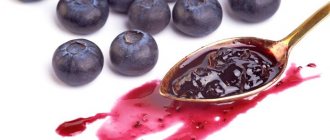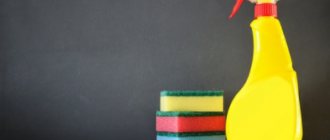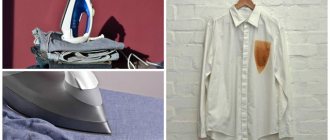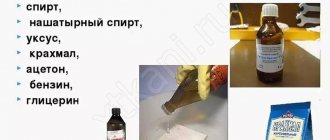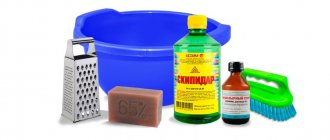Every housewife is familiar with the problem of greasy stains on trousers, shirts or dresses. They are almost impossible to scrub off and remove during hand or machine washing, so you have to use various methods to get rid of the problem at home.
How to remove a greasy stain from suede, linen or cotton fabric? How to wash fat from trousers, shirts or dresses correctly and quickly? What products are needed for white or colored fabric? Folk remedies will come to the rescue.
Popular recipes for fat on things
“Honey, oink-oink!”
Try to get rid of the stain on your favorite clothes as soon as possible. And the available items from the first aid kit, kitchen cabinet, and bathroom will help with this. Here's how to remove a greasy stain on clothes using simple, but proven and reliable products:
- dishwashing gel . The following names are usually recommended: “Ferry”, “Frosh”, but I also used the cheaper “Gala” gel, it also helps. A variety of this remedy is especially praised - “Gala lemon”. Treat the greasy stain with gel, gently rubbing it in with your finger. Throw it in the machine. While you prepare the rest of the things, add the powder, the product will work and will not spoil anything. Start the wash. If you wash by hand, 5-6 minutes are enough for the effect, otherwise this area can be bleached. The method is suitable even for nylon tights, polyester and the like;
Advice from Chistyuli. Using inexpensive gels, sprinkle baking soda on top - it enhances the effect of dishwashing detergent.
- table salt . Wet the stain with warm water. Sprinkle salt thickly and lightly rub it into the fabric. Leave for 30 minutes. Do the laundry;
- salt + baking soda . Mix the ingredients in equal proportions, dilute with warm water to a paste consistency. An important condition is not to rub, because salt can damage the material;
- table vinegar 9% + water . A method for light-colored items. Mix both components in equal parts. Apply to dirt. Leave it for about 20 minutes. The stain will begin to disappear literally before your eyes.
Advice from Chistyuli. Special washing signs on clothing labels will help you wash them correctly and without harm to the item.
Laundry soap
This method is the cheapest of all listed. All you need is laundry soap. In most cases, it deals with almost all stains. Soap has antibacterial properties and easily destroys their structure.
Removal method:
- It is enough to smear the place where the dirt is located and leave it in this condition for the whole night.
- The next morning, you need to rinse the stained area with powder and it will become clean.
It is best to use regular 72% laundry soap.
It is sold in almost every hardware store. Laundry soap helps remove even the most difficult stains. It is advisable to wash your clothes after the procedure, since the smell of laundry soap does not have a pleasant aroma. The cleaning method is suitable for any type of fabric. Soap does not spoil the color and preserves its structure.
Fresh grease stains: how to remove?
Try to deal with the thing before the fat blob gets old. Here's what you can use to remove a greasy stain while it's still fresh:
- ammonia 10% . An aggressive product that can bleach fabric. Do a preliminary test (more on this below). If the item passes the test, apply ammonia to the dirty area and wait 15-20 minutes. Rinse and wash;
- absorbents . Sprinkle generously with one of the cleaning products. Cover with a napkin. Place the weight and leave for 30 minutes. Shake off the powder. If the stain is not gone yet, repeat. Then wash your clothes;
Advice from Chistyuli. How to remove a grease stain in the most environmentally friendly way for clothes? Absorbents are powders that absorb vegetable and other fat well. The list includes starch, soda, talc, baby powder, crushed chalk, tooth powder, white clay (kaolin). They are used before washing off the fat. Try!
- shampoo for oily hair . Use it undiluted. Apply a small amount to the stain and rub in. Leave for 15-20 minutes and throw in the washing machine;
- fresh lemon juice . Squeezed directly onto clothes, fresh juice can cope with light stains. The recipe is good for thick sportswear, sweatshirts, etc.;
- soap (laundry soap, gall soap, Antipyatin). Lather the stain, then soak the clothing in warm, soapy water. Leave it overnight. Or put the soaped item in a plastic bag and seal it tightly. Wash all this mess out in the morning. Good luck!
Advice from Chistyuli. Ammonia has a very pungent odor. If you inhale its vapors, you can get a burn to your mucous membranes. Never sniff an open bottle and keep ammonia away from your nose.
Bread crumb
It is worth immediately taking into account that this method is effective only for stains that were placed quite recently. The crumb of fresh bread works best. It is soft and easily absorbs all moisture and fat. Dry crumb will be less effective in this case. Also, the crumb of the bun is not able to remove all stains. Basically, it removes only fatty contaminants. If you apply the crumb of the bun to the place where the fat got in, the crumb will begin to absorb all the fat, and it will gradually become less noticeable.
This method is used most often if there is no more effective remedy nearby.
Also, this method does not guarantee complete elimination. You should wash the item to be sure that no stain remains. One of the advantages is that this method can be used for all types of fabric without fear that the fabric may lose its color. If you wish, you can try others after using this method.
Old grease stains, how to remove?
Most often, we notice trouble when the item is washed, dried and lies on the ironing board. By this time, the old fat had had time to be properly absorbed. Similar stories happen especially often with kitchen towels. How and what to use to remove an old grease stain without harming your clothes? Use the heavy tools of experienced housewives:
- refined gasoline . It is easy to buy in departments for smokers - lighters are refilled with purified gasoline. Wet the stain generously with the product and leave for 15-20 minutes. Do the laundry;
Advice from Chistyuli. When removing stains with gasoline, acetone or turpentine, first moisten the fabric around the stain with water. Then the contamination is treated with the selected product. The precaution will prevent a circle from forming around the stain.
- glycerin . It turns out that this medicine is useful not only for the skin, but also for clothes. Apply slightly heated glycerin in a water bath to the oil blot. Leave for 20 minutes. Wash this area with soap;
- mustard _ Both dry powder and ready-made seasoning without additives are suitable. The powder will have to be diluted to a paste consistency. Apply all this beauty to the fat and rub it in. After 30 minutes, rinse in warm water and wash. Be careful - mustard can leave specific stains on dark clothes. Test required;
- salt . Also, stubborn old fat can be softened by soaking in hot brine. Dissolve 5 tbsp in a liter of hot water. spoons of salt. If the item is large, increase the proportions. Soak your clothes in this solution. Periodically clean the dirty area with your hands. Do the laundry.
Advice from Chistyuli. Pre-treat any lingering oily marks with steam. Or put the item between two layers of loose white paper and iron it with an iron, periodically replacing the paper with clean paper. After that, use any other method - it will work faster and more efficiently on heated fat.
Useful tips
- Always try to remove fresh stains immediately, before they have time to set in, otherwise dealing with them later will be quite problematic.
- Use a clean (unnecessary!) toothbrush instead of working the stain with your hands.
- Gently rub in the selected products using light circular movements, moving from the edge of the grease marks to the middle.
- Don’t forget to treat not only the front side, but also the back side of the trousers, especially if the fat has already leaked out.
- To avoid staining your trousers while eating, place cotton napkins or towels on your knees. It’s easier to wash these fabrics than to remove stains from your favorite things.
Important! We will also tell you how to remove brilliant green from leatherette.
Extreme and unusual methods for fat loss
Suitable for fabrics that are not afraid of ammonia or boiling. These are, as a rule, clothes made from natural fabrics. For example, jeans. Before you start, test the paint’s resistance to bleach and read the tag: will the item withstand high temperatures? Choose what you can use to conveniently remove greasy stains from clothes:
- ammonia 10% + turpentine . Let me remind you that ammonia (aka ammonia) often bleaches fabrics. Below I will tell you how to do the test correctly. If the test was successful, wet the stain with a mixture (1:1) of both substances. Leave for 30-40 minutes. Then thoroughly wash the affected “skin” with good powder;
- table salt (or starch). Here's how to remove a grease stain from jeans using this simple remedy. Pour 150 g of the substance into a liter of boiled water. Stir and place the contaminated clothes in it. Hold until the water becomes warm, then scrub the stain with a brush or your hands;
- Polish for hair . Spray it on the dirt. Try not to get into neighboring areas. When the varnish saturates the fabric, cover the area with a napkin and press lightly. After 15-20 minutes, wash this area with soap. Then wash the entire item;
- aspirin . Crush acetylsalicylic acid (aspirin) tablet. Dilute with warm water to a paste consistency. Rub into the stain. Leave for 30-40 minutes, covering with plastic to prevent it from drying out. The acid contained in the pill bleaches the fabric. But this medicine is especially effective against blood stains.
- magnesia + medical ether . Mix 100 grams of each product. Wet the stain generously. Leave until the smell of ether wears off. Do the laundry.
Advice from Chistyuli. Here's how to wash off milk and mayonnaise. Grease that gets on clothes while eating can be easily removed by a borax solution. This miracle is sold in pharmacies. Mix a tablespoon of the product in a liter of warm water. Soak the thing. Let it sour a little and wash it.
The nuances of cleaning sports and dress pants
Classic office trousers require delicate handling . Such items cannot be cleaned with chlorine-containing compounds or gasoline (trouser fabric sheds a lot). Steam cleaning is also prohibited (high temperatures cause the fabric to shrink and smooth out the creases on dress pants).
In order to get office trousers in order, grease stains are first rubbed off with laundry soap or covered with salt, and then sent to the wash.
Cleaning sweatpants from grease stains is much easier. This type of clothing is made from wear-resistant fabrics that can withstand washing with any powders and stain removers.
Different types of tissues and fat
There are so many fabrics, so many recipes, because each material has its own character. How to remove grease stains on jeans (denim), tulle, organza and other things?
Light fabrics
Prepare a mixture of crushed chalk and refined gasoline that is unappetizing for fat (we need the consistency of the slurry). Apply to the problem area of clothing and rub lightly with your finger. Leave for several hours. Carefully remove any remaining chalk with a brush. Wash in warm water with soap.
This way you can wash cook’s clothes, tablecloths, bedding, thin linen and fabrics that don’t need to be rubbed hard.
Fabric of any color
Mix 1 teaspoon each of ammonia and dishwashing detergent. Dilute in 0.5 cups of warm water. Treat the stain, cover with a blotter and iron with a not very hot iron.
Cotton (cotton, cotton), linen
It seems so democratic, this fabric is very reluctant to give up dirt. Before you wash off grease stains on cotton clothes, generously sweeten his life. Soap the oil blot with laundry soap and sprinkle with sugar. Leave to act for 30-40 minutes, covering with plastic.
Denim material is especially capricious - you never know whether the fabric will lighten or not. Therefore, when washing jeans, the method with absorbents (see above), dish gel, and laundry soap is especially convenient.
Knitwear
Knitted fabrics are cleaned using medical alcohol (vodka) and fine table salt. Soak the contaminated area of fabric in alcohol and place it on a hard surface. Apply a thick layer of salt. Cover with a napkin and place the weight. Leave it overnight. In the morning, shake off the salt and wash.
Delicate fabrics
Synthetics, chiffon, satin and other delicate fabrics are easily damaged when washed. But the alkalis that make up laundry (or gall) soap can quickly, carefully and effectively dissolve the oil trace. Wet the cloth and soap with warm water. Lather the contaminated area thickly. Leave it to soak overnight. Then wash it.
Recipes for tricky fabrics will help you figure out how to remove a greasy stain from trousers so as not to ruin your dress fabric.
It’s especially difficult for Clean in the kitchen...
Silk fabrics
Mix glycerin (1 tbsp), ammonia (0.5 tbsp), water (1 tbsp). Apply to dirt using a cotton pad. After 10 minutes, rinse. The method is also effective against stains from cosmetics and creams.
Wool
Tooth powder, chalk, soda, talc will come in handy. Sprinkle any of these products generously onto the stain. Gently rub into the fibers with a soft brush (or a toothbrush). Cover with a paper towel and lightly run a warm iron. Place the weight and leave it overnight. In the morning, shake out, wash with soap, rinse.
Velvet, plush
These delicate vulnerable materials are cleaned with fresh bread. Form a ball of pulp and roll it over the stain. The bread will absorb the oil molecules.
If the bread crumb doesn't do the job, use turpentine. You can safely wash colored robe and home suits with this product. The recipe is described just above.
Leather, dermantine
The most suitable remedy is onion juice. You can squeeze it through the garlic and rub in with a cotton pad. If the stain is small, an onion cut in half will suffice. Rub the mark with a damp cut. Renew the cut periodically so that the juice continues to be released. After cleansing, wipe the problem area with a damp cloth.
After cleaning, the skin will acquire a characteristic onion smell. You can easily get rid of it by wiping the area with a slice of lemon. Or fresh zest (after all, lemon juice can whiten the skin).
Tulle, curtains
Curtains and curtains in the kitchen often suffer from greasy splashes. So, if you fry fish, sizzling drops cannot be avoided. How to remove old greasy stains from delicate tulle? Use the recipe with ammonia. Why dissolve 2 tablespoons of 10% ammonia in warm water and treat the stain.
Tracing paper
The main advantage of this method is that it can be used on clothes made of any material. It should also be mentioned that not all stains can be removed using this method. It mainly helps with grease and wine stains.
This method for removing stains is used quite often.
Several sheets of tracing paper are placed on the surface and back of the clothing and ironed. As a result, due to the capillary effect, everything that was in the stain will begin to rise and will be absorbed into the paper. This method is safe for fabric. The fabric will not discolor and will not change its properties. The surface of the fabric will remain virtually untouched. Also, using this method you can remove stains that have been on clothes for quite a long time.
Advice! Using tracing paper, you can remove stains not only from clothes, but also from paper and wallpaper.
Bachelor manners
If you are a hungry man and in a hurry dropped a cheburek on your best shirt, don’t say “fuck”, but just read these recipes. They are taken from the forums of men who have not yet acquired a housewife or do not live near their mother.
Method No. 1
Very popular with men who save clothes with their own hands.
- You will need shaving foam. No foam?! Take shaving gel.
- Rub the product into the stain and leave for 10-15 minutes. Rub this area with your hands. If the spot seems too big and scary to you, repeat a couple more times. The main thing is not to rub the hole.
- Throw your clothes into the washing machine. Pour in the powder and start the wash. You can add any other things to the shirt. In short, continue washing as usual.
- A curtain.
...and also our dear men remove rust from bolts with Coca
Method No. 2
Here's another way that men praise vying with each other. They say that this method even removes machine oil that gets on once white clothes.
What are the types of grease stains on clothes?
The statute of limitations plays a decisive role in this case. For example, I can easily wash off greasy marks using regular soap (baby soap, laundry soap) or “Gala.” It is enough to soap and rub everything properly. Let it sit. Rub some more. Wash. And things are like new.
- Fresh grease stains . Those that are no more than 3 hours old. They are easy to remove even with simple baby or laundry soap.
- Stubborn stain . Then the stain becomes ingrained. Fat molecules penetrate deep into the tissue. They may need to be washed several times. And, of course, you will have to use special means.
- Old stain . As a rule, they either appear later (after all, not all oil stains are noticed by the housewife right away). Or these are the things that were put off to be washed until later. Dealing with long-standing contamination is very difficult. Especially if you've used an iron on them. Repeated washing + folk remedies help get rid of stubborn dirt that has begun to get old. But even then, yellow stains and even lightened areas, stains, stains may remain on the clothes. That's why you need to fight fat as quickly as possible.
A whole arsenal of remedies listed in this huge article will help you cope with any type of fat stains. Choose the appropriate way to remove old grease stains from any type of fabric! If a candle left an oily trace, Chistyulya has recipes for this case too.
Toothpaste
Toothpaste is not only a remedy for the oral cavity, but is also a good stain remover. It removes dirt especially well from white surfaces. It is also worth considering that the design or color may fade a little. But it all depends on the stain. The withdrawal method is quite simple. To do this, you only need toothpaste and a brush.
Toothpaste contains quite complex chemical elements that are capable of destroying dirt to varying degrees.
Sequencing:
- Apply the paste evenly to the surface and gently rub in with a brush.
- Next, you should leave everything in this state for 5-10 minutes.
- Afterwards you need to rinse with water.
Several treatments may be required to completely eliminate fat.
Can be repeated several times. This method is effective for old and new stains. Also, everything happens quite quickly and does not require special preparation.
How to remove grease stains correctly
- Clean your clothes from dust and litter. Otherwise, you will add dirty, difficult-to-remove stains to the oily trail. For this you will need a dry brush.
- First, make sure that it is really a greasy stain in front of you, and not some other kind. How to do this is described in detail in the corresponding article. Follow the link directly.
- Cover the fresh stain with a paper towel and gently press with your hand. Do not spread the fat onto adjacent areas of the fabric. You can put a weight on top and leave it for a while. Change the napkin periodically to a clean one.
- When treating dirt, move from the edges to the center.
- Place a board wrapped in a clean cloth under the contaminated layer of clothing - this will prevent grease and stain removers from reaching the clean areas. This advice is relevant for pants, sleeves and other “tubular” clothing that cannot be unfolded.
- Place clothes that can be laid out in one layer on a hard surface. For example, on a table covered with a paper towel.
By treating a stain incorrectly, you can make it “eternal”
Chalk
It should be remembered that it is best to use regular white chalk for the board, since many types contain wax or dye. You can keep it on a shelf in the kitchen for immediate use.
Chalk works best on fresh stains.
The procedure goes as follows:
- First you need to remove all excess with a paper towel.
- Next, cover the entire contaminated surface with chalk.
- Before throwing the item into the washing machine, apply a small amount of stain remover or powder to the stain.
There will be no stain left after washing.
Very often, various athletes use chalk to keep their hands dry and not slip due to fat. It is also used in dry shampoos.
Fatal mistakes in the fight against fat on clothes
- Do not iron greasy, oily marks. This way the fat will be “baked”, quickly turn yellow and it will be almost impossible to wash it off.
- Do not exceed the dosage of components indicated in the recipe. It is better to increase it gradually, bringing the recipe to the desired consistency.
- Washing in cold water, although not as critical as ironing, is also not very useful. You probably know that fat melts in heat and is easier to wash off. But in cold water, oil, on the contrary, becomes tanned.
- When treating stains with extreme products, wear rubber gloves. Ventilate the room or go outside.
- White items wash better, but may take on a yellow tint. Use the “services” of salt and ammonia. To remove yellowness, the next time you wash, add a little ammonia diluted with water into the washing machine;
- Colored things can also lose color - as if they fade. To remove greasy marks from dyed fabrics, it is appropriate to use dish gel, soap, or a delicate stain remover. Check the durability of the fabric using a special test.
- You should not try to clean an expensive item from grease that has already begun to eat in. It's better to go to a dry cleaner.
TEST for clothing resistance to processing
Before removing the oil trace, perform both tests:
Paint fastness
- Choose an inconspicuous place on the garment: the inside of a pocket, indents on seams or lapels, the inside of a collar, a spare piece of fabric that some conscientious manufacturers still sew on. Or, in the end, conduct a test on another - similar in structure - fabric.
- Apply the chosen product and leave for 20-30 minutes.
- Evaluate the result: if nothing happened to the fabric, you can safely wash the entire thing.
Fabric durability
- Read what is written on the label. As a rule, the temperature that is permissible for a given fabric is indicated there.
- However, it happens that the information does not correspond to reality and ironing and boiling spoil clothes. Therefore, first set the iron to 1.5-2 settings and carefully try to iron from the inside out. Gradually increase the heat of the Teflon sole of the iron, each time moving the toggle switch by 0.5 settings.
- Synthetics, natural and artificial silk, wool are afraid of boiling. They either “shrink” or become like a “reaper” fabric that can no longer be smoothed out. Just imagine your favorite blouse being lost... Don’t do that...
Steam treatment
The most effective and easiest way. It is also often used in dry cleaning. This method is suitable for every fabric. Steam treatment can remove plaque, dust, stains and hair. This method is suitable for removing stains that have been on clothing for quite some time.
You can perform steam treatment using an iron with a steam generator, or hold the item over a pan of boiling water. To enhance the effect, you can use other removal methods. Steam treatment is gentle on clothes and does not cause any harm to them. This method is also the safest among others. In this way, you can treat not only clothes, but also towels and scarves.
Steam, which is supplied under high pressure, irritates fat cells, which contributes to their disappearance.
Review of ready-made grease stain removers
The products listed below have received numerous positive reviews from housewives. They are used to wash away stains that have refused to be washed off with home remedies. Do you have your own recipe? Share with us in the comments!
- gel "Vanish"
- stain remover "Stork"
- stain remover "Eared nanny"
- Antipyatin soap
- Pasta-7
- gall soap
- "Bos Plus Maximum"
- "Sorbent"
- "Agidel"
- "Just a minute"
- "Elta"
So…
Dear Clean!
Happy experimenting in the kitchen! And now you’re not afraid of fat - just add this article to your bookmarks Dear Neat! Thank you for your interest in the article. Add this site to your bookmarks right now, and “Clean” will support your household habits with new – interesting, large, mega-useful articles.
And let your home warm you with warmth and comfort!
Share useful information with your friends:



